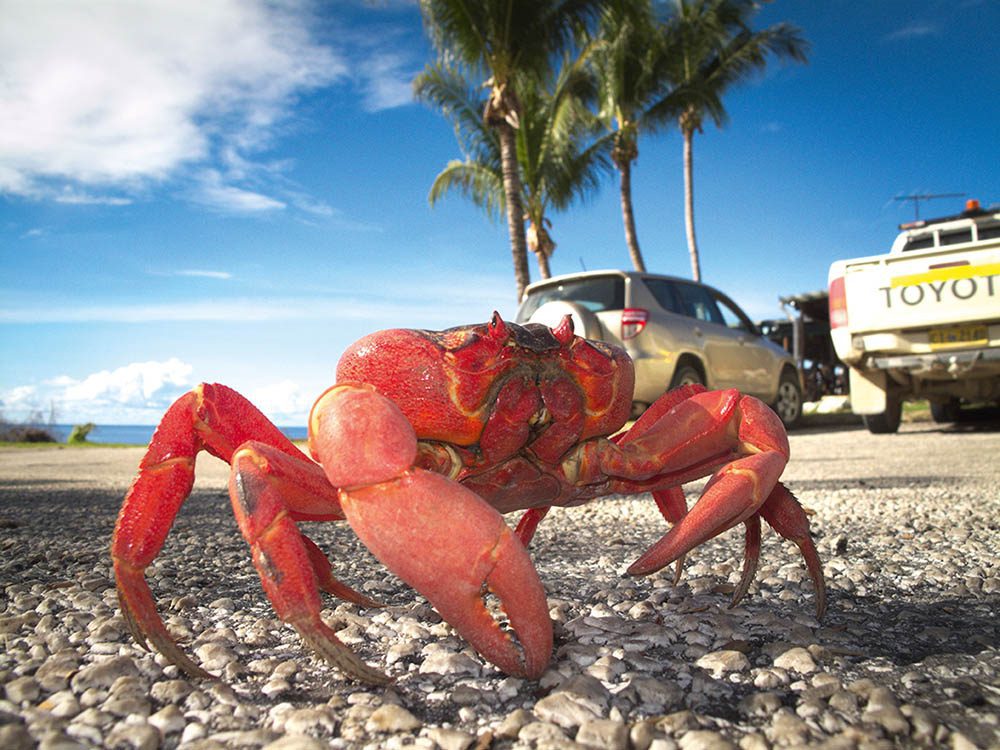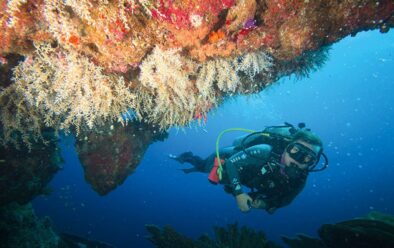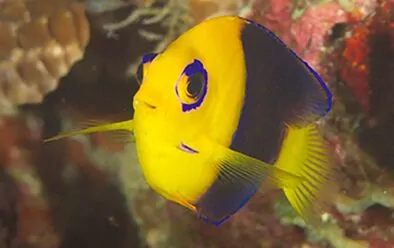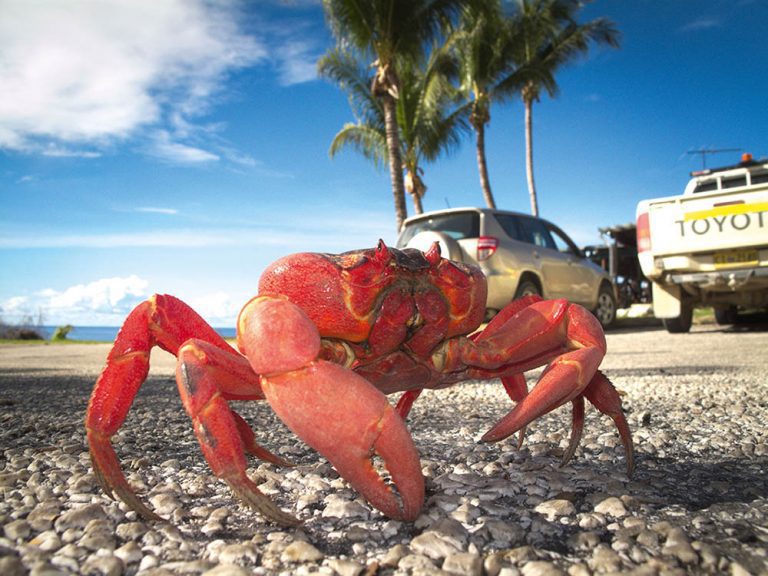PACIFIC DIVER
Christmas on Christmas Island
Associated with its scuttling red crabs, there is a lot more to Christmas Island, as JOHN LIDDIARD finds when he slips under water

Red Crab.
There is something special about islands miles from anywhere. Such isolation leads to endemic species and unique eco-systems, especially where human habitation has been relatively recent, without time to mess things up too much.
The effects of isolation are most telling on land, but also extend under water. Think of the Galapagos, or Hawaii and other islands in the middle of the Pacific.
Christmas Island is located in the Indian Ocean more than 200 miles from Indonesia, isolated by water thousands of metres deep. The best-known inhabitant arising from this isolation is the red crab.
This endemic land crab ventures back to the shore once a year in a mass-spawning migration.
Close to the sea, the males dig burrows where mating takes place. The females stay in the burrows and brood their eggs for a couple of weeks, and then get as precariously close to the sea as they can to release the eggs into the water.
The crabs have lost their ability to swim or breathe in water, so spawning is a finely judged game of dangling off rocks or running up and down the beach, perhaps getting splashed but not swept away.
This final act of spawning all happens at a dawn high tide, on the last quarter of the moon in November or December.
The bulk of this is on just one day, with a few early and late comers on the days to either side.
Precisely which lunar cycle it is depends greatly on the weather over the preceding months. Divining the exact date is a black art practised by locals who sometimes can’t make up their minds.
Sometimes the crabs can’t make up their minds either, and there is a double spawning 28 days apart.
The eggs immediately hatch into larvae which swirl about with the tide and grow through several stages. A month later, tiny young crabs climb out of the sea and scuttle their way back into the jungle.
Appeared in DIVER July 2018
It isn’t a here and there thing. Millions of crabs make the journey to the sea every year. Some roads are closed for the migration season. Others are fenced and crossed by specially built crab tunnels and crab bridges.
Car and truck drivers carry brooms in case they need to move crabs from the road instead of running them over.
The school runs a crab sign-painting competition, where the best signs are placed by the roadside to remind drivers to avoid squishing the crustaceans.
Red crab migration on Christmas Island is a big thing.
The actual spawning, and even the swimming young coming ashore, is not really a diving thing. But the possibility of whale sharks attracted by the temporary boost in plankton certainly is a diving thing, so my trip isn’t designed to catch the spawning or young coming ashore. It’s right in the middle, which just happens to be over Christmas.
Christmas on Christmas Island. It has a nice ring to it. How could I resist? But would I see any of the famous red crabs?
While I might be late for the spawning – and my flight from Jakarta has arrived late after being delayed for most of the day – I don’t have to wait long for my first red crab. There’s one scuttling around the bathroom of my cabin.
In the morning I pass a few more, crossing the road to the Extra Divers centre. Yet more are running about by the jetty when we board the dive-boat.
A couple of days later I have long lost count. For the full crab experience, I also enjoyed taking an island tour with an expert guide (see panel overleaf).

Visitors can see thousands of crabs without getting into the sea. Perhaps all these crabs could offer an attraction for an underwater photography course, with live models on land on which to practise before going diving.
Anyway, to the diving and the marine life. A fringe of reef typically shelves to anything between 10 and 20m and then breaks sharply to a wall that just plummets.
Not that depth is a good idea. It’s more than 1500 miles to the nearest chamber on the Australian mainland. So all dive profiles are extremely conservative, with plenty of safety-stop time.
We head out to Rubbish Tip, just along from Rocky Point. Australians don’t shy away from calling a spade a spade. Here the dive-site is named after the location ashore where the tip used to be.
Having just been muck-diving in Indonesia, the most immediately noticeable thing about Rubbish Tip is that there is no rubbish. None at all. No plastic, tins, scraps of rope or truck-tyres.
It looks as if we can depend on the “give a dive-site a name” inverse truism here. The residents of Christmas Island look after their environment, and what we find is a good covering of hard coral, though there are some signs of bleaching in the shallows.
Big mushrooms of coral shelve down along a submerged extension of the point, then break into a wall.
The prettiest endemic species, the Christmas Island angelfish, might not be absolutely everywhere, but it can be found readily enough almost everywhere when we look. It has a bright yellow body with vibrant blue patch and mask.
As angelfish go, it’s tiny. If I hadn’t asked about endemic species in advance I would have mentally ticked it off as a variety of damselfish, or at most as a juvenile version of one of the better-known angelfish species.
But a pretty little angelfish it is. The rest of the site? It’s a wall of hard coral.
The isolation that leads to endemic species works both ways. Some of the fish species and critters you would expect to see everywhere in Indonesia have not spread across the Java Trench to Christmas Island.
Extra divers’ boat is a sizeable aluminium hull with cabin and toilet, twin four-stroke outboards and diver-ladders each side of the stern.
From the jetty in Flying Fish Cove we alternate sites east and west, while keeping in the shelter of the island from the seasonal south-easterly wind and weather.
I find the dives to the west more interesting, especially at Northwest Point and beyond.
Although there is at least a gentle current at every site, it is on this wall and at sites nearby that occasional gorgonians become copses, then forests.
Away from Flying Fish Cove, the shoreline for the rest of the island is limestone cliffs with jungle above. It’s easy to see why Christmas Island remained uninhabited for so long.
Round the west end of the island, a series of streams break through the cliffs at the Dales. These valleys are popular hiking destinations ashore.
From the sea, all we can see are undulations in the jungle canopy that cuts out to the sea through narrow canyons, some with barely visible strips of sand that are popular with beach-goers.
From a diver’s point of view, similar geological processes have cut caves beneath the cliffs, emerging at or below the waterline and pounded open
by the sea.
The cliffs are not a Swiss cheese as at some places, but pretty much every dive-site has one or more caves available in the shallows. With up to 20 divers on the boat, we often have a staggered start, or do the dive with two groups in opposite directions to avoid overcrowding the caves.
For a second dive after Rubbish Tip, Lost Lake Cave has a complex multiple entrance that doesn’t really go anywhere. Who cares? It’s the entrance that’s pretty.
The divers are a comfortable mix of tourists and residents. Extra Divers provides biscuits and nuts for between dives and local divers bring home-baking to share.
Everyone I meet on Christmas Island is friendly and has plenty of enthusiasm for the environment.
There is one roundabout on the island, around which is a series of boards for locals to post notices about anything from social events to swapping domestic appliances. If people drive round it three times slowly, it’s not because they’re on their way home from the pub, it’s because they’re reading the messages.

Thinking of which, the bad news is that only one pub is open through my stay. The good news is that it’s opposite the dive-centre.
Just behind Northwest Point, Perpendicular Wall starts, or ends, with a jagged diagonally sheared slash into the cliff that shallows to a rocky slope at the back. The rest of the dive is aptly described by its name, but so are many other of the sites.
The shallows at Full Frontal are a maze of coral ridges and a swooshing surge, much more than at other sites on this sheltered side of the island.
Perhaps that’s how the site got its name, though you never know with Australians; the naming could be more basic… The canyons lead to another cave.
The deepest cave is the aptly named Thunder Dome. It winds back into the cliff to surface beneath a ceiling of stalactites and flowstone, proof that the original path was cut by an underground stream-way at a time of lower sea level.
The air is safe. There are even some red crabs scuttling about on ledges. They can’t swim, so there must be a crack down through the roof. Every now and then we feel the compression and boom of a wave funnelling into the entrance.
It’s a frustrating dive for camera-lens selection. This is one of the nicest caves for wide-angle, but I am then frustrated when one of the other divers finds a really cute nudibranch on the way back out. All I can do is watch those with more flexible compacts zoom in on it.
Highlight of the week and my last dive of the trip is right at the tip of Northwest Point, following the submerged line of the headland out along a ridge with walls to either side. It’s a dive that needs to be approached with caution, because the current heads offshore and builds as we get further out and the ridge drops away.
Venture too far and let the current get hold and you could be lost forever in the Indian Ocean.
Grey reef and whitetip sharks patrol the wall, usually deeper but occasionally along the reef – always tantalisingly out of reach. Barracuda are a little bit more
co-operative and then, just as we’re about to head up and launch a DSMB for our safety-stop, a shoal of jack makes my dive, first dividing past me, then swirling around.
Despite the red crab spawning, we get no whale sharks for Christmas. Readers should know better by now – never go looking for whale sharks with a bloke called John from DIVER magazine.
Brief history of Christmas
Uninhabited Christmas Island was discovered by Richard Rowe in 1615, but not named until Christmas Day 1643, by Captain William Mynors.
The island remained largely unexplored until the late 1800s. The growth in human population came in 1899 with the discovery of phosphate deposits.
The island was administered as part of the British Empire through Singapore, and in 1942 it was occupied by the Japanese.
In 1958 Australia purchased the island from Singapore, and life on the island is now much like that in any small Australian town.
Land Tours
Decompression day comes around and we have a guided nature tour with Lisa from Indian Ocean Experiences. It’s a half-day morning or afternoon.
With the equatorial heat I elect for the morning – it’s good to start before it gets too hot.
Lisa is knowledgeable and enthusiastic about the whole ecology of Christmas Island. While the endemic red crabs are the most obvious land crab, there are several other species.
Most common are the blue crabs – like red crabs, but a little timid – and robber crabs, also known as coconut crabs.
Robber crabs are the largest land arthropod, growing to weigh about 4kg. They can be found from Zanzibar to islands in the central Pacific, and are listed as a vulnerable species.
My first encounter with a robber crab sees me trying to coax it out of the way with a broom, resulting in it scuttling under Lisa’s Landcruiser.
They can move pretty fast when motivated, and I wouldn’t want to be on the receiving end of a nip from one of their claws.
Lisa gives instructions to keep it in place as she carefully backs the car away so that I can chase it into the bushes.
We arrive at the Dales at the south of the island for a walk through the forest to a waterfall at Hugh’s Dale. Outside the migration season, this is typical natural habitat for crabs, with burrows showing through a largely cleared jungle floor.
The crabs eat most of the detritus, including picking the bones of anyone who gets lost and dies in the rugged terrain. Or maybe that’s just Lisa’s story to keep us on the marked path.
Like the Galapagos, the isolation of Christmas Island has led to a unique ecology with many endemic species.
Allowing some time for a land tour is a must.
FACTFILE
GETTING THERE> John Liddiard flew with KLM and Garuda via Amsterdam to Jakarta. After an overnight stay at the FM7 hotel, Christmas Island is a short flight with Garuda. An Australian visa, free online, is required before travelling.
DIVING & ACCOMMODATION> Extra Divers is a PADI/SSI centre and has nitrox available, extradivers-worldwide.com. The dive-centre can arrange self-catering accommodation at the nearby Sunset property, which has 12 rooms.
WHEN TO GO> Any time, but the mass red-crab events occur in October and November and whale-shark season is November to April.
MONEY> Australian dollar.
PRICES> Booking through Dive Worldwide, you can get seven nights’ room only, 10 dives with Extra Divers, flights with Garuda, an overnight in Jakarta and transfers from £2145pp, diveworldwide.com
VISITOR Information> australia.com

